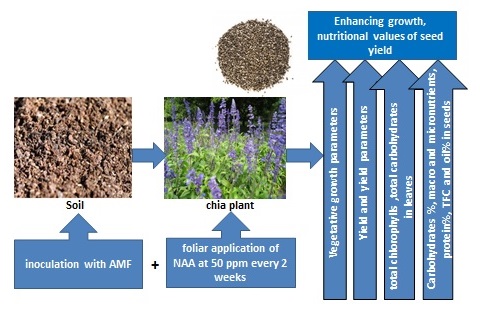Responses of different quality parameters of Chia to arbuscular mycorrhiza and plant growth regulator

Published 2021-03-30
Keywords
- AMF,
- hormones,
- nutritional values,
- Salvia hispanica,
- seed yield
How to Cite
Copyright (c) 2021 Hossam Ahmed Ashour Hossam, Sanaa Esmail, Asmaa El- Attar

This work is licensed under a Creative Commons Attribution 4.0 International License.
Abstract
Field experiment was conducted to evaluate the influence of arbuscular mycorrhiza fungi (AMF) and foliar spray of plant growth regulators (PGRs) and their interaction on vegetative growth, seed yield and yield attributes and some biochemical criteria of chia (Salvia hispanica L.), in a split plot design with three replications. Plants grown in absence or presence of AMF were sprayed every 2 weeks with benzyl adenine (BA), CPPU [N-(2-chloro-4-pyridinyl)-N’-phenylurea], common name forchlorfenuron, and Naphthalene acetic acid (NAA) at 50, 20 and 50 ppm respectively, while control plants were sprayed with tap water. The results revealed that, inoculation with AMF generally caused significant augmentation in all studied growth, yield and yield attributes, total chlorophylls and carbohydrates content in leaves, augmentation in nutritional values of seeds like carbohydrates %, macronutrient, micronutrients, proteins %, total flavonoids, oil % compared to non-inoculated plants. In absence or presence of AMF, application of PGRs generally caused significant increases in the studied parameters compared to control. The interaction between NAA and AMF was more effective since gave higher increases in the studied parameters. It can be concluded that, cultivation of chia plant in presence of mycorrhiza with foliar application of NAA at 50 ppm is recommended for enhancing growth, and nutritional values of seed yield.





